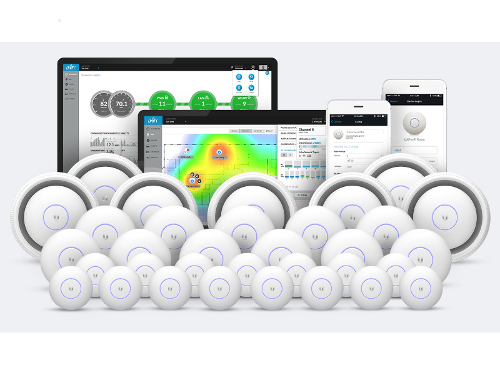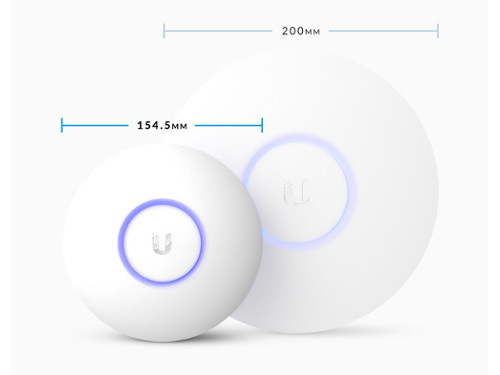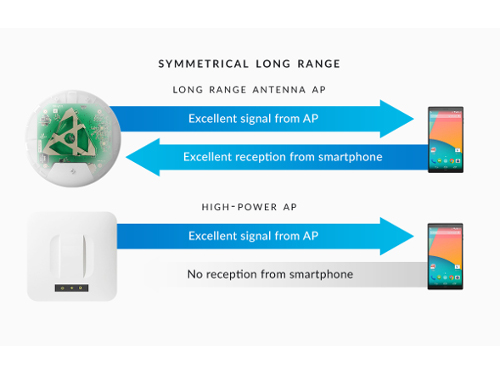The UAP-AC-Lite
The AC-Lite is the entry-level product for Ubiquiti’s new range of AC access points. As the name suggests it is both the smallest and lightest of the UAPs measuring just 160 x 160 x 31.45 mm and weighing in at 170g (185g with the mounting kit). It boasts speeds of up to 300Mbps on the 2.4GHz band and 867Mbps on the 5Ghz band, and a maximum range of 125m (400ft).
The UAP-AC-LR
The AC-LR is the long range offering from the new AC access points. It is slightly larger and heavier than the AC-Lite, measuring 175.7 x 175.7 x 43.2 mm and 240g (315g with mounting kits) respectively, but is still smaller than its predecessor the UAP-LR. It also boasts higher antenna gain on the 5GHz band as well as higher transmit power when compared to the AC-Lite, however the transmit power is limited to the same level in the UK and Europe. A 3×3 3 dBI Tri-Polarity antenna configuration allows up to 300Mbps on the 2.4Ghz band and a 2×2 3 dBI Tri-Polarity antenna for the 5Ghz band allows a maximum through put of 867Mbps.
The UAP-AC-PRO
The AC-PRO is the high-performance option from the new range of Ubiquiti AC access points. There has been no size reduction from the previous model and the AC-PRO weighs in at 350g (450g with mounts) making it the heaviest of the new AC models. One advantage of this is that it can use the standard UAP mount as it is the same size. It also comes with two gigabit ethernet ports whereas the AC-Lite and AC-LR only have one. It also boasts 3×3 MIMO technology for each band allowing speeds of up to 450Mbps on 2.4GHz and 1300Mbps on 5GHz.
Performance Test
We recently had the opportunity to perform some in-house testing on the AC-Lite and the AC-LR to see how they squared up against the older UAP-AC. We tested the quality of the signal in a ‘real world’ scenario by measuring the RSSI values for the three different access points at various locations around our office building. At nearly point blank range the newer AC products were already pulling ahead with average RSSI values of -33 for the AC-Lite and -36 for the AC-LR compared to -50 for the UAP-AC. The trend continued when measuring from a medium distance through several, reasonably thin, walls: -55 for the AC-Lite, -57 for the AC-LR and -71 for the UAP-AC. Our final test was performed at the maximum possible distance with many obstructions and again the newer devices prevailed with scores of -80 for the AC-Lite, -77 for the AC-LR, and -90 for the UAP-AC.
As expected, the new AC models out-performed the older UAP-AC in all our tests with one minor caveat; the UAP-AC has a maximum throughput of 1300Mpbs which is higher than both the AC-LR and the AC-Lite. Having said that, the new UAP-AC-PRO also has a maximum throughput of 1300Mbps. We recently had the opportunity to test the UAP-AC-PRO and, as expected, it performed admirably with average scores of -37, -64, and -71 for short, medium, and long ranges respectively. These are significantly better than what the UAP-AC was capable of and the UAP-AC-PRO is priced far more attractively too making it a worthy replacement for the older AC unit.
 LinITX Blog Ubiquiti & MikroTik Wireless Networking Experts
LinITX Blog Ubiquiti & MikroTik Wireless Networking Experts







